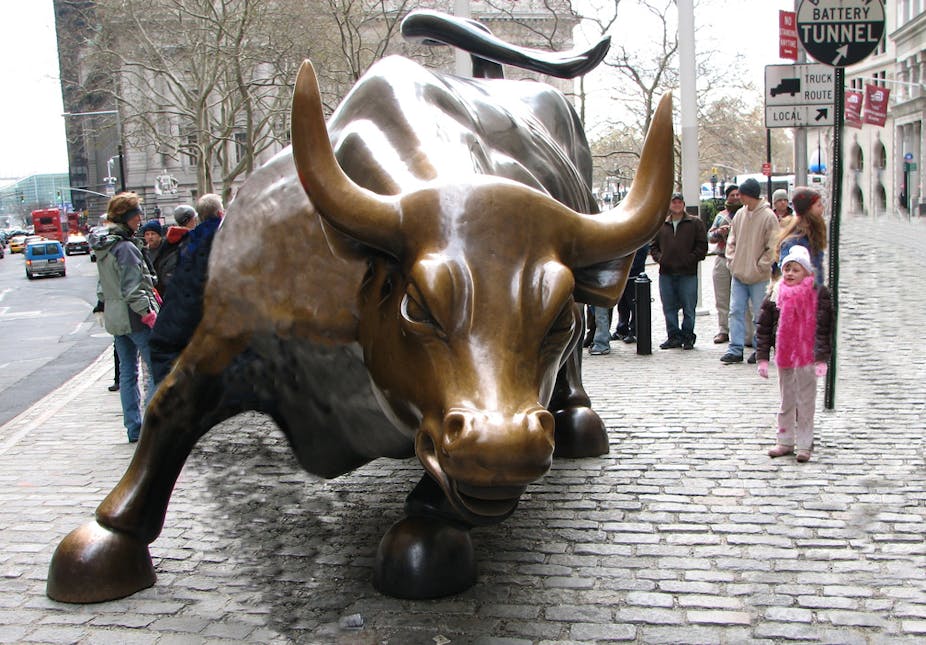In times of financial uncertainty and crisis, high stress reactions lead to traders becoming more risk averse, which drives pessimism and further falls in finance, according to a new study. This is because of high levels of the “stress hormone”, cortisol, in bankers.
We all take risks, but in the financial sector the stakes are even higher – decisions and actions can influence market stability, economic growth and the fortune and woes of nations. And the new study, published in PNAS, helps us understand the physiological nuts and bolts of risk taking among traders.
When we’re stressed higher levels of cortisol are secreted into the blood stream. The body responds with a number of stress-related changes including increased heart rate and arousal, heightened memory and lower pain sensitivity. But it can also impair cognitive function, increase blood pressure and affect how we approach risk.
Emotional finance
The researchers observed how a placebo or high levels of cortisol similar to that experienced by traders affected how risk prone or averse a group of 36 volunteers became over an eight-day period (a previous study in 2008 suggested that market volatility over an eight-day period could increase average daily cortisol levels in traders by 68%). They were then given computerised tasks that involved choosing to playing a lottery that offered the certainty of a monetary return – a high chance of winning £30 or a lower chance of winning £90 – or a lottery with a higher chance of winning £90 but also some chance of receiving £0. The researchers found that higher and longer exposure to the hormone led more participants to opt for the less risky first choice.
This is important because it suggests that in continually stressful situations – such as a financial crisis – traders will tend to take less risky positions. When many traders do this all it once, it means they will dump the high or moderate risk assets (such as equities or complex derivatives) they coveted during the good times, and seek out lower risk “vanilla” assets (such as government bonds). This kind of herding instinct will further depress the price of more risky assets, accelerating the bursting of the bubble. All because of a hormone in our body.
The results of this study might lead some banks and policy makers to jump to the conclusion that if they can control traders’ hormones, then they could deal with boom and bust cycles. This would be to over-reach the conclusions of the study. Cortisol isn’t the whole story; there are many other studies of trader’s risk preferences which show that they are affected by things like emotion, cognitive perspective, personality and the amount of sleep traders have.
Over three decades, research in behavioural economics has also alerted us to how our risk preferences tend to be quite different depending on how an issue is framed. For instance, if a situation is described as “gambling” or “insurance” it results in very different behaviour to those working in that situation. Similarly, if losses are emphasised (rather than gains), then people also tend to behave in different ways.
One particularly interesting recent study looked at the impact of the way ethics policies were framed impacted on risk taking. It found that if you played up the positive benefits of ethics, then people were more likely to take greater risks and engage in more unethical behaviour. In contrast, if you focused on the need to comply with ethical rules, then you were likely to get far less risk taking and less unethical behaviour.
Body, mind and soul
Attempts to get at the physiological and neurological basis of markets have become wildly popular in recent years. A number of researchers have tracked traders’ physiological markers and brain activity in different settings. These ideas are now being put into practice. One London-based asset manager has started to use some of the tools from this “self-quantifier movement” to begin tracking the detailed behaviour and bodily signs of their traders. They hope that by logging in what they ate for breakfast, the firm can look out for potential correlations between bodily states and trading outcomes.
Working this out does not just create greater stability in the financial sector. It might appeal to many traders who are often performance junkies, looking for any edge possible. Some already use life-tracking technologies in their daily life to do things like help improve their sleep.
But it’s also clear that such moves could give rise to the deepening of surveillance and control in financial organisations. Instead of just having results and trading behaviour scrutinised, physiological and neurological movements would also be an object of monitoring and control. This could easily give a new dimension to idea of big brother in the workplace. Even more concerning is if these new techniques of employee bio-surveillance were extended out of the trading floor and into other apparently risky occupations, such as nuclear power plant operators, airline pilots, surgeons, oil rig operatives and so on.
This might seem like a reasonable risk management technology, but many employees would interpret it as showing a lack of trust in their abilities and reduced autonomy. We know from many studies that increased surveillance and reduced privacy lead to bad organisational outcomes such as less experimentation, more distraction, less continuous improvement, and ultimately less productivity.
As the researchers of the new study point out, many influential models in economics, finance and neuroscience have assumed approach to risk is a stable trait, especially in sectors where people work in and are trained in the business of risk. But we are physiological beings after all, and since the financial crisis in 2007 it has been increasingly realised that risk is much more dynamic. And more focus is rightly being turned on how exactly our individual physical reactions can affect what we do and the world trading floor.

